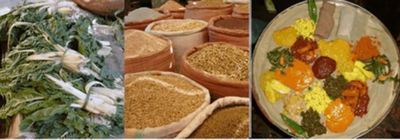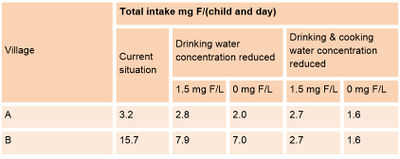Evaluating fluoride intake via food and water using a Material Flow Analysis
NOTE: Article from the Geogenic Contamination Handbook
In the Ethiopian Rift Valley, 41% of all the sources of drinking water have fluoride concentrations exceeding the World Health Organization guideline value of 1.5 mg/L and dental and skeletal fluorosis is widespread (Tekle-Haimanot et al., 2006). In an effort to mitigate disease related to fluoride intake, water treatment options are being sought and tested (see Section 9.1 for an example). As listed in Table 3.3 (Chapter 3), the daily maximum fluoride intake is around 1.5 mg for infants and 10 mg for adults. From these figures, it is clear how easily these limits can be reached by drinking contaminated water. However, there is also a fluoride input via food and food preparation (using contaminated water for cooking). In order to make daily intake estimates, it is necessary to know, firstly, the pathways along which substances can be taken up by the body. These pathways may be, for example, via beverages, food, inhalation (air), medication or personal care products (pathway analysis). Secondly, we need to quantify the amount of the substance of concern per pathway. Material Flow Analysis (MFA) is very helpful in this. MFA is a method designed to account systematically for the material, substance and energy use of a defined system. Based on an economic input–output analysis (Leontief, 1936), MFAs were originally developed in the chemical engineering sector for process optimisation. In the mid-1980s, these methods were further developed by Baccini and Brunner (1991) to account for the material, substance and energy flows in whole regions. The MFA was extended by Baccini and Bader (1996) to yield Mathematical Material Flow Analysis, which incorporated modelling concepts to provide a systematic description and simulation of substance flows through a defined system. In the past two decades, this method has been applied to many problems in different fields and on different scales (for an overview, see Schaffner et al., 2009).
The MFA procedure is shown in the following four subsections using the example of fluoride intake by children in the Ethiopian Rift Valley, based on the work of Malde et al (2011).
Contents
Model approach
The model approach used in our example is the so-called “consumption recipe model”. It is based on a knowledge of nutrient or contaminant concentrations in beverages and foodstuffs and on the average daily consumption of these beverages and foodstuffs, either alone or as ingredients in different dishes. For a more detailed description of the model, see Malde et al. (2011).
System analysis

In the first step, we need to define the system to be modelled. Our example comprises the preparation of food and its consumption by a child. These two activities are defined as “processes” and are represented by boxes within the system boundary. In Figure 9.11, the processes are termed kitchen and child. The next step is to determine the pathways by which the intake of fluoride occurs. Of the possible pathways (inhalation, medication and cosmetics, beverages and food), only beverages and food are relevant in the Ethiopian Rift Valley, as there are no factories there emitting fluoride into the air, and little medication, toothpaste or cosmetics are used. In our example, two groups of intake pathways can be identified: (i) Ingredients used in cooking, such as water, vegetables, fish, etc., and (ii) Products that are directly consumed (i.e., milk and whey). The ingredients of a typical meal are shown in Figure 9.12.
Data collection and calibration
In order to run the model described above, the following data are needed:
- The daily consumption of food and beverages
- Recipes
- Fluoride concentrations in the ingredients used
- Fluoride concentrations in prepared dishes (using the duplicate method)
Possible data sources are: field studies, literature, interviews with experts, estimates and surveys. Clearly the data must be checked carefully and compared with data from other sources, if available. The full data set for the case described above is presented in Malde et al. (2011) and references therein. Using this data set, all flows of fluoride shown in Figure 9.11 were calculated. The model was calibrated by comparing the total fluoride intake calculated from the sum of the beverages and food consumed per child each day with measured intake of fluoride in dishes sampled using the duplicate method (see Malde et al., 2003, 2004).
In the duplicate method of dietary assessment, a duplicate portion of all food and drink consumed throughout the day is prepared. The identical portions are weighed and recorded. The duplicate portion is taken to the laboratory, where it is chemically analysed. Sometimes, multiple days of assessment may be combined into a single composite and then be homogenised before analysis.
Simulation and results
The calibrated model was used in two scenarios:
- Village A with a water source fluoride at a concentration of 2 mg/L and
- Village B with a water source fluoride at a concentration of 14 mg/L
The following calculations were made:
- The average total fluoride intake per child per day.
- The comparison of food, food preparation and beverages to the total fluoride intake.
- The contribution of each item to the total fluoride intake.
The simulated fluoride flows for village A are shown in Figure 9.13 (top). From the total intake of 3.2 mg F/day per child, 38% comes from drinking water, 25% from water used for cooking and the remaining 37% from the food. The situation in village B is different (see Fig. 9.13 bottom). Here, 56% of the total intake (16 mg/day per child) comes from drinking water and 37% from the water used for cooking. Only 7% of the total intake comes from food. Next to water used for drinking and cooking, teff flour and tea are significant sources of fluoride. Obviously a child living in village B has a very high fluoride intake, but the fluoride intake of a child living in village A is also too high. Given that the recommended maximum daily fluoride intake for children below 8 years of age is 0.1 mg/day per kg of body weight, and assuming that a three-year old child weighs about 13 kg, the child’s daily intake should not be above 1.3 mg/day (SCSEDR, 1997). The model can now be used to simulate the effect on the average total daily fluoride intake of children if the fluoride concentration in drinking and cooking water were to be reduced to 1.5 or 0 mg F/L. The results are presented in Table 9.6. The results show quite clearly that a reduction of the fluoride concentrations in drinking and cooking water to 1.5 mg/L does not sufficiently reduce the average total daily intake of fluoride by children to the recommended maximum. The content of the water needs to be lowered further, preferably towards 0 mg F/L, since the food ingredients themselves already contain about 1.2 mg F. For more details and the results of further scenarios, see Malde et. al (2011).
References
For references, please visit the page References - Geogenic Contamination Handbook.


